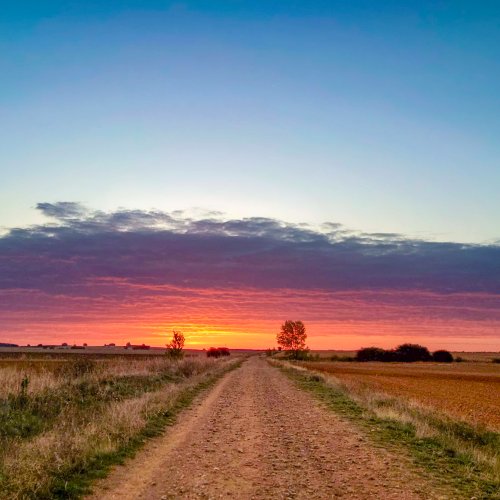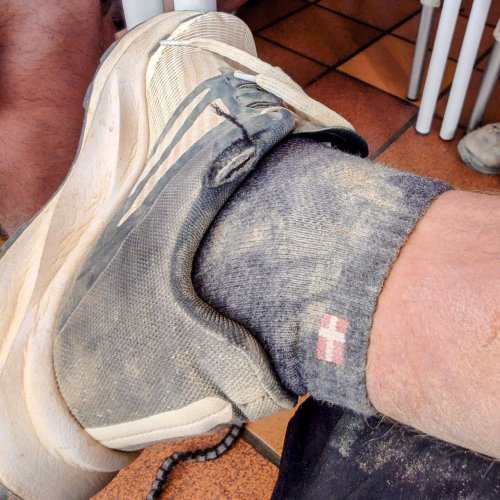F
Former member 60103
Guest
Walking Caminos not only marked my retirement, . they were also the point I returned to the long distance hikes of my youth. Of course I have travelled inbetween times but maybe more as an independent tourist as opposed to a traveller.
Nothing much had changed in the interim apart from the fact that I soon became aware (on the Frances) of an almost constant "clicking" sound when in front or behind groups or individuals. This was of course the intrusive sound of metal tipped walking poles being slammed onto rocks, tarmac and paving slabs. I also watched as people used the poles in situations where (elderly) locals were walking completely unaided ie. across flat plazas. Bizarre.
As I watched these poles in action it soon became obvious that they were being used in numerous different ways and given that I almost always walked past the people using them by natural pace I got to asking myself "what is the point of walking poles".
I googled "how to use Walking Poles" so appreciate that there is a semblance of technique behind using the things in some circumstances but most of the people I saw seemed to have missed the point. Do the poles come with instructions ? In fact I only ever saw one person using them in any sort of way that seemed to fit what I had read - and even then, rest assured, the poles spent most of the time attached to his back-pack.
My own observational user guide:
1.The Swinger (thought this would grab your attention). Ensure that on the back swing the poles on both sides are swung out at an angle from the body approaching 45 degrees so as to ensure that when you do hit someone you get the lower leg as opposed to the more muscular upper part.
2. The Kerb Grater. Works on one side only depends on what side of the road you are walking on. Ensure that the metal tip rasps down the outside of the kerb before hitting the tarmac this ensuring the noise is maximised. This technique also requires that you be in a trance like state that prevents you from moving sideways to the degree needed to avoid hitting the kerb
3. The Pusher. First ensure that the poles are low enough (below waist height) so that you push down on them rather that pull down on them. This ensures that whatever effort you use is directed straight down. What this achieves is anyones guess.
4. The Skier (my favorite). Obvious really, use both polls in tandem as in skiing but without the snow. I have (without poles) tried to replicate this with my arms whilst trying to walk normally. I failed , it's actually quite difficult as it is not a natural walking rhythm, so hats off to anyone who has this move perfected.
5. The Slammer. Completely flat road/track/paved plaza required here. Slam the, preferably metal tipped, poles hard down to produce the loudest noise possible. Then present an appearence of complete blissful ignorance as to the noise created versus any perceived material benefit.
6. The Technician. As in "this looks dodgy, I think it's time to get the poles out". The poles were just going into use as I made the bottom of the slight hill and looked back to see what progress these technical aids had provided the user. Answer very little but he did at least look like he knew what he was doing.
7. The Pointer. Best seen in Santiago walking in front of the cathedral. Walks across plaza (still using poles) then randomly points out to companion some elevated feature seemingly oblivious to the fact that attached to the end of their hand was 4 foot + of pointy stick. The speed of this move was awesome.
7. The Golfer. Uses a number 7 golf club in place of a stick. Obviously accessed the wrong Camino user forum. Suprisingly seemed to benefit from the added weight, grip and amount of area in contact with the ground.
8. OK I made the last one up .
So I have to ask what is the point of these ergonomically handled, aircraft grade carbon fibre, collapsible, cool coloured and expensive walking sticks. I feel qualified to ask having walked nearly 4K klm with at least 8Kg pack over many gradients, surfaces and in various temperatures in the last 2 years without poles and never feeling the need for poles. The pilgrims I met without poles also shared all if not most of the same opinions as well. Someone has made a lot of money from these things. I have some very expensive glass hammers and sky hooks for sale if anyone is interested !
Nothing much had changed in the interim apart from the fact that I soon became aware (on the Frances) of an almost constant "clicking" sound when in front or behind groups or individuals. This was of course the intrusive sound of metal tipped walking poles being slammed onto rocks, tarmac and paving slabs. I also watched as people used the poles in situations where (elderly) locals were walking completely unaided ie. across flat plazas. Bizarre.
As I watched these poles in action it soon became obvious that they were being used in numerous different ways and given that I almost always walked past the people using them by natural pace I got to asking myself "what is the point of walking poles".
I googled "how to use Walking Poles" so appreciate that there is a semblance of technique behind using the things in some circumstances but most of the people I saw seemed to have missed the point. Do the poles come with instructions ? In fact I only ever saw one person using them in any sort of way that seemed to fit what I had read - and even then, rest assured, the poles spent most of the time attached to his back-pack.
My own observational user guide:
1.The Swinger (thought this would grab your attention). Ensure that on the back swing the poles on both sides are swung out at an angle from the body approaching 45 degrees so as to ensure that when you do hit someone you get the lower leg as opposed to the more muscular upper part.
2. The Kerb Grater. Works on one side only depends on what side of the road you are walking on. Ensure that the metal tip rasps down the outside of the kerb before hitting the tarmac this ensuring the noise is maximised. This technique also requires that you be in a trance like state that prevents you from moving sideways to the degree needed to avoid hitting the kerb
3. The Pusher. First ensure that the poles are low enough (below waist height) so that you push down on them rather that pull down on them. This ensures that whatever effort you use is directed straight down. What this achieves is anyones guess.
4. The Skier (my favorite). Obvious really, use both polls in tandem as in skiing but without the snow. I have (without poles) tried to replicate this with my arms whilst trying to walk normally. I failed , it's actually quite difficult as it is not a natural walking rhythm, so hats off to anyone who has this move perfected.
5. The Slammer. Completely flat road/track/paved plaza required here. Slam the, preferably metal tipped, poles hard down to produce the loudest noise possible. Then present an appearence of complete blissful ignorance as to the noise created versus any perceived material benefit.
6. The Technician. As in "this looks dodgy, I think it's time to get the poles out". The poles were just going into use as I made the bottom of the slight hill and looked back to see what progress these technical aids had provided the user. Answer very little but he did at least look like he knew what he was doing.
7. The Pointer. Best seen in Santiago walking in front of the cathedral. Walks across plaza (still using poles) then randomly points out to companion some elevated feature seemingly oblivious to the fact that attached to the end of their hand was 4 foot + of pointy stick. The speed of this move was awesome.
7. The Golfer. Uses a number 7 golf club in place of a stick. Obviously accessed the wrong Camino user forum. Suprisingly seemed to benefit from the added weight, grip and amount of area in contact with the ground.
8. OK I made the last one up .
So I have to ask what is the point of these ergonomically handled, aircraft grade carbon fibre, collapsible, cool coloured and expensive walking sticks. I feel qualified to ask having walked nearly 4K klm with at least 8Kg pack over many gradients, surfaces and in various temperatures in the last 2 years without poles and never feeling the need for poles. The pilgrims I met without poles also shared all if not most of the same opinions as well. Someone has made a lot of money from these things. I have some very expensive glass hammers and sky hooks for sale if anyone is interested !

































